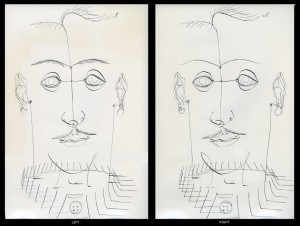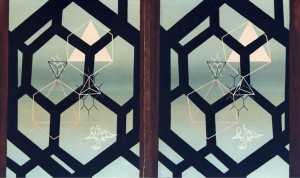A highlight of this year’s McLaren 2014 celebrations was the screening at the Edinburgh International Film Festival of Norman McLaren’s stunning 3-D films from the early 1950s, painstakingly digitally-restored by the National Film Board of Canada. The fascinating history of these ‘lost’ films was recently told on the Canadian Animation Blog, and the films will receive another screening at MoMa in New York in November.
McLaren’s interest in the creative possibilities of stereographic art is recorded in a set of papers which were recently donated to the University of Stirling Archives by Prof. Harold Layer of San Francisco State University. Prof. Layer corresponded with McLaren in the 1970s and 1980s about his 3-D film work, these letters forming part of the collection. It also includes copies of stereoscopic drawings and paintings created by McLaren in the 1940s which Prof. Layer has documented on a very useful online resource.

The material also includes a set of reports and articles written by McLaren in the 1940s and 1950s, noting the new approaches offered by stereographic drawing and providing technical notes for the 3-D films he produced for the National Film Board of Canada. In 1946 McLaren wrote a proposal for the Guggenheim Museum in New York, seeking support for his research into the new field of sterographics which he defined as “the art of doing a separate drawing, painting, sculpture or mobile for each eye, which when viewed together, will synthesize a new additional dimension.”

McLaren argued that this method of drawing offered “Freedom from the physical laws of a three-dimensional world.” He went on to argue that:
“The laws of physics such as balance and gravity need not operate in this type of three-dimensional space created by stereoscopic synthesis. Apparently solid objects, heavy substances, complex structures and liquid matter may float in space, needing no support and existing by a sort of auto-suspension. The renaissance painter, with his growing awareness, gradually realized that he, on his flat surfaces, was released from such laws, and the first Umbrian angels who rose a few timid inches from the ground were soon to lead the imagination to a magnificent world of soaring form. Today’s stereographic drawings are like those Umbrian angels, for they point to a world where angels may ascend with a new magnificence into the very three-dimensional substance of space itself.” (Ref. GAA 31/F/7/2/2)
A later annotation to this document shows that many of McLaren’s plans remained unrealized. In the introduction of the paper he wrote that:
“It is my intention to go much further, and open up stereography as a creative medium. I am writing this paper on the basis of my past researches, my present conclusions, and my future plans.”
Beside the words “future plans” McLaren added an annotation in red pencil in 1980 which read “unfulfilled as yet.”